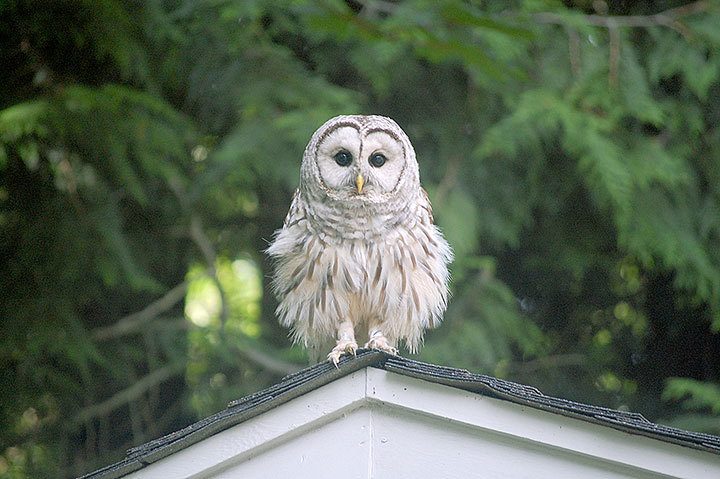Instead of counting sheep to fall asleep, Jamie Acker counts owls to wake up.
One barn owl, two barn owl, three.
From midnight to sunrise on Dec. 17, the high school teacher will be out in the heart of the forest, hooting and chirping and screeching for the Christmas Bird Count, a Kitsap Audubon tradition since 1973.
In the late nineteenth century, commercial market hunters were slaughtering 5 million birds a year to supply feathers for women’s hats. At Christmastime, teams of sportsmen competed to see who could kill the most birds and small game in a single day for “Side Hunt,” and many species of birds were bordering extinction.
Frank Chapman, an Audubon ornithologist, had had enough, so, subverting the tradition, he created a new competition, in which counting birds was the prime objective. The Audubon wildlife census is now 117 years strong, 43 locally.
“On a really good, big year for owls here, I can get a dozen to 18 owls on a night,” Acker said, noting that weather is a major interferer. “Owls shut down in wind and rain.”
The species he finds depends on the time of year.
“We have some species that migrate through, like the short-eared owl,” Acker explained. “We also have two records of snowy owls who were one-day wonders.”
Others are year-round residents, including the barred owl, the barn owl and the great horned owl.
Western screech-owls used to be the most common species during the summer, but Acker says their population was extirpated.
The island’s winter majority has also declined this year, though Acker doesn’t know why. Northern Saw-whet owls have a healthy rate of reproduction — 3-to-1, young to adults here — but for some reason they’re not surviving.
“My associates in British Columbia have noted the same trend,” Acker added.
That’s the beauty of the Christmas Bird Count. It’s not a solitary endeavor, but a worldwide citizen science event, whereby birdwatchers in North, South and Central America share valuable data with one another and track changes in population.
In Kitsap, there are nine teams covering a 15-mile diameter circle centered at the County Fairgrounds in Bremerton.
Lee Robinson leads the count of birds on the south end of Bainbridge Island and George Gerdts helms a team of a dozen in the north.
The owls get their own tally-taker, Gerdts explained, because they’re nearly impossible to spot.
“Finding owls in the daytime is excrutiatingly hard and sheer luck,” he said.
Better to try at night, when the nocturnal creatures are most likely to hear Acker imitating them.
Gerdts’ team sleeps in late, beginning I-Spy (a duck, a sparrow, a Hooded Merganser!) near the Agate Pass Bridge around 8 a.m. From there, they slink along the shore to Dock Street, then to Battle Point and Phillis Young’s easement.
They carry telescopes for sighting waterfowl and have a few tricks up their sleeves for shyer species.
“If you make noises in their territory, like an owl or even like a squirrel, they’ll often come in to investigate what that is because there’s survival value in knowing where your predators are,” Gerdts explained.
That practice is a bit controversial, though, since it disrupts normal activities.
“You use it judiciously,” Gerdts said, adding that it’s important to consider the bird’s well-being first and foremost.
The retired middle school science teacher has been doing the count since the mid-’90s. He usually averages between the high sixties and mid seventies, in terms of the number of species sighted.
“It’s fun statewide to compare notes,” Gerdts said.
Bragging rights go to the Audubon chapter with the most comprehensive census, which is inevitably Sequim, with its volunteer power and diverse terrain. They often hit above 140 species.
That doesn’t spoil Gerdts’ fun, though. He delights in his birds, rare and common, and in the circle who delights in delighting in them.
“It’s fun to meet new people who come out for the first time; it’s also fun to get together with friends who have been birding with me for the last 20, 25 years,” he said.
And it’s really fun to spot a wintering straggler or a rariety like the Northern Pygmy Owl, a one-time resident that’s been MIA since 1996.
Results, historical and present, can be viewed at www.netapp.audubon.org/cbcobservation. Audubon chapters hold their Christmas Bird Counts between Dec. 14 and Jan. 5, so check back in the new year for a comprehensive picture.
To join the owl prowl, contact Acker at 206-499-7121 or owler@sounddsl.com.
Seattle Audubon also has openings for experienced and novice volunteers. This year, their Christmas Bird Count will take place on Saturday, Dec. 31.
Visit my.seattleaudubon.org/events/-/e100391 for more information or to register.



